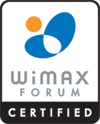
MIMO
WIMAX PHY layer takes advantage of time diversity through interleaving, frequency diversity through OFDM and spatial diversity through MIMO techniques. Antenna diversity using smart antenna systems such as MIMO plays an important role in the 802.16e specifications for:
- increased link reliability
- increased capacity/ data rates
- increased range/ coverage
MIMO generally refers to three multiple antenna techniques: Transmit-Receive Diversity (Matrix A or STBC), Spatial Multiplexing (Matrix B) and Beamforming (Adaptive Antenna Systems). A logical design should include all these features in an adaptive manner. Matrix B operates by splitting the signal to be transmitted into multiple data streams, each data stream transmitted from a separate base station antenna during in a single frequency-time resource allocation. Spatial multiplexing or Matrix B effectively doubles the transmit capacity of a 2X2 system in a multi-path environment where signal-to-noise ratio is high. As one moves away from the transmitter, the noise begins to overwhelm transmitted signal. In conditions where link reliability rather than bandwidth is a concern, such as edge of a cell, the systems switches to Matrix A or spatial diversity that provides robustness to the signal. Matrix A increases the coverage area of a cell by transmitting the same signal from multiple antennas, each transmission being orthogonal to the rest, reducing self-interference and increasing the probability of at least one signal arriving correctly at the receiver.


